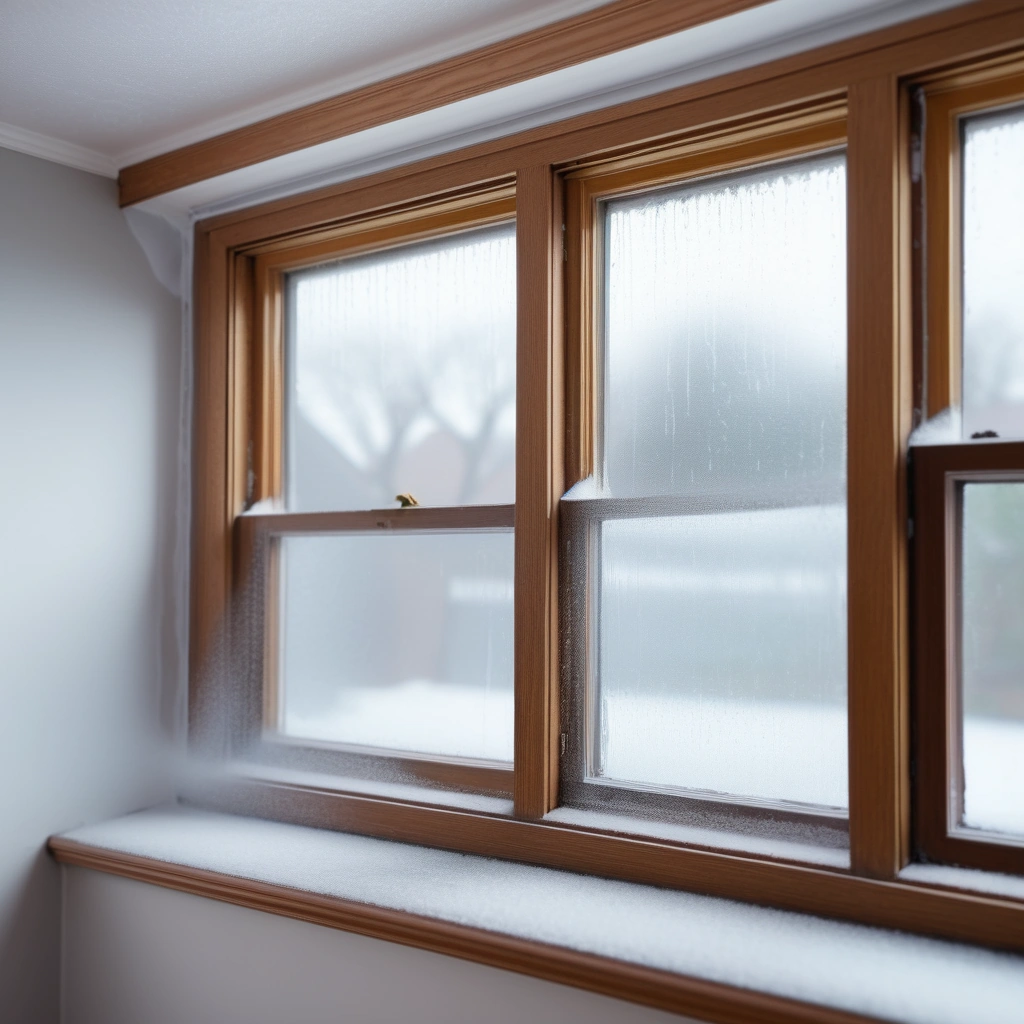Conquer Window Condensation: A Homeowner’s Guide to Prevention and Control
Understanding the Window Condensation Problem
Window condensation, those misty droplets that cloud your view, is a common household nuisance, often dismissed as a mere aesthetic inconvenience. However, this persistent dampness is far more insidious. Beyond obscuring your view, unchecked window condensation can escalate into significant home maintenance issues, fostering mold and mildew growth, compromising indoor air quality, and even causing structural damage like wood rot around window frames. This is particularly concerning in older homes with single-pane windows and inadequate window insulation, where temperature differentials are more pronounced.
Indeed, the presence of window condensation is frequently an indicator of underlying problems related to humidity control and energy efficiency within the home. High indoor humidity, often stemming from everyday activities like cooking, showering, and laundry, coupled with poor home ventilation, creates an environment ripe for condensation. Addressing window condensation, therefore, is not just about wiping away the moisture; it’s about implementing holistic home improvement strategies that enhance energy efficiency, improve air quality, and safeguard your property’s structural integrity.
Ignoring this issue can lead to costly repairs and health problems down the line. This guide provides homeowners with a comprehensive understanding of window condensation, exploring its root causes and offering actionable solutions to prevent condensation and control its effects. We’ll delve into lifestyle adjustments, DIY fixes, and professional upgrades, empowering you to create a comfortable and healthy home environment free from the detrimental effects of excessive moisture. By prioritizing window insulation, ensuring proper home ventilation, and adopting proactive humidity control measures, you can effectively combat condensation and protect your investment.
The Science Behind Condensation: Causes and Types
Window condensation occurs when warm, moist air comes into contact with a cold surface, causing the water vapor in the air to condense into liquid. Think of it like a cold glass of lemonade on a summer day – the moisture in the air around the glass turns into water droplets. Several factors contribute to this phenomenon in homes. High Humidity Levels: Excessive moisture in the air, often from activities like showering, cooking, or even the presence of numerous indoor plants, significantly increases the likelihood of window condensation.
Temperature Differences: Significant temperature differences between the inside and outside of your home, a common occurrence especially during colder months, exacerbate the problem. The greater the temperature disparity, the more likely condensation is to form on window surfaces. Poor Ventilation: Inadequate airflow traps moist air inside your home, preventing it from dissipating naturally and creating an environment ripe for window condensation. This is especially true in tightly sealed modern homes where air exchange is limited.
It’s crucial to distinguish between condensation forming on the inside versus the outside of your windows. Interior window condensation, the primary focus of this guide, is a strong indicator of elevated indoor humidity levels. This type of condensation signals a need to improve ventilation or reduce moisture sources within the home. Exterior window condensation, on the other hand, often occurs on well-insulated windows and is usually a sign of good energy efficiency. It indicates that the window surface is cooler than the surrounding air, especially on clear nights when radiative cooling is at its peak.
This is because the window is effectively preventing heat from escaping the house, leading to a cooler exterior surface. Understanding dew point is also key to grasping condensation. The dew point is the temperature at which air becomes saturated with water vapor, and condensation begins to form. When the surface temperature of your windows drops to or below the dew point of the air inside your home, window condensation will occur. Factors such as the type of window (single-pane vs. double-pane), the presence of thermal breaks in the window frame, and the overall insulation of the window unit all influence the surface temperature of the glass. Energy-efficient windows are designed to maintain a warmer surface temperature, thereby reducing the likelihood of condensation. Furthermore, consider that different areas of a window may experience varying degrees of condensation due to localized temperature differences or drafts.
Lifestyle Adjustments: Simple Steps for a Drier Home
Addressing window condensation requires a multi-pronged approach, starting with simple lifestyle adjustments that can significantly impact indoor humidity levels. Improve Ventilation: Strategically using ventilation is paramount. Employ exhaust fans in bathrooms and kitchens during and after showering or cooking; these activities release substantial amounts of moisture into the air. Open windows periodically, even briefly during colder months, to introduce drier, fresh air and displace moisture-laden indoor air. According to the EPA, proper ventilation not only reduces condensation but also improves overall indoor air quality by removing pollutants.
Ensure proper airflow throughout your home by keeping doors open to encourage circulation and avoiding blocking vents with furniture or curtains, which can trap humid air in specific areas. Reduce Indoor Humidity Sources: Many everyday activities contribute to indoor humidity. Cover pots while cooking to trap steam, and ensure your clothes dryer is properly vented to the outside; an unvented dryer releases significant moisture into your home. Avoid overwatering indoor plants; while aesthetically pleasing, they can be a notable source of humidity.
Consider using a clothesline instead of a dryer when weather permits, an energy-efficient choice that also minimizes indoor moisture. Even seemingly minor adjustments, such as promptly wiping up spills and repairing leaky faucets, can collectively reduce humidity levels and help prevent condensation. Monitor Humidity Levels: Investing in a hygrometer is a simple yet effective way to track the relative humidity in your home. Aim for a relative humidity between 30-50%. Levels consistently above 50% create an environment conducive to condensation and mold growth, while levels below 30% can lead to dry skin and respiratory irritation.
Adjust your lifestyle and home environment based on the hygrometer readings. For instance, if humidity levels are consistently high, consider running a dehumidifier or increasing ventilation. Conversely, if levels are too low, a humidifier can add moisture to the air. Regularly monitoring and adjusting humidity levels is a proactive step in preventing window condensation and maintaining a healthy indoor environment. Furthermore, consider the impact of your heating system. Forced-air heating can exacerbate condensation problems if not properly balanced. Ensure that your vents are adjusted to provide even heating throughout your home, preventing cold spots where condensation is more likely to form. Regular maintenance of your HVAC system, including changing filters, can also improve its efficiency and reduce the amount of moisture it introduces into the air. A well-maintained system contributes to both energy efficiency and effective humidity control, reducing the likelihood of window condensation.
DIY Fixes: Practical Solutions for Immediate Relief
For more persistent window condensation, several DIY fixes can offer immediate and noticeable relief. Window Film Application: Applying a thin layer of window film is a surprisingly effective method to prevent condensation. This film acts as an insulator, increasing the surface temperature of the glass and reducing the temperature differential between the window and the room’s air. Select a film designed for insulation; these typically have a low-E (low-emissivity) coating that reflects heat back into the room, boosting energy efficiency.
Before application, thoroughly clean the window surface to ensure proper adhesion and avoid trapping dust or air bubbles. A smoother application improves both aesthetics and performance, contributing to long-term humidity control and preventing recurring window condensation. Weather stripping is another crucial element in the fight against window condensation. Seal any gaps and cracks around window frames and sashes with high-quality weather stripping to prevent cold air infiltration and the escape of warm, moist air. Focus on areas where the window meets the frame and where the sashes overlap.
Consider using different types of weather stripping for different areas; foam tape works well for small gaps, while V-seal or felt strips are suitable for larger openings. Regularly inspect weather stripping for wear and tear, replacing it as needed to maintain an airtight seal. Proper installation and maintenance of weather stripping contribute significantly to window insulation, reducing energy bills and preventing condensation. Regular window cleaning is often overlooked, but it plays a vital role in preventing condensation.
Dust, dirt, and grime on the window surface can attract and hold moisture, creating an ideal environment for condensation to form. Clean windows regularly with a mild detergent and water, ensuring you dry them thoroughly afterward. For stubborn stains or buildup, consider using a specialized window cleaning solution. Pay particular attention to the edges and corners of the window, where moisture tends to accumulate. By keeping your windows clean, you not only improve their appearance but also reduce the surface area available for condensation to form, contributing to better humidity control in your home.
Absorbent materials placed strategically can further combat window condensation. Consider placing small, decorative trays filled with desiccant crystals near windows prone to condensation. These crystals absorb excess moisture from the air, helping to lower humidity levels in the immediate vicinity of the window. Replace or recharge the desiccant crystals regularly, following the manufacturer’s instructions, to maintain their effectiveness. Alternatively, placing small, rolled-up towels or moisture-absorbing cloths along the window sill can help wick away any condensation that does form, preventing it from pooling and potentially damaging the window frame or surrounding drywall. These simple, cost-effective measures can provide an extra layer of protection against window condensation and its associated problems.
Upgrades and Professional Help: When to Call in the Experts
If lifestyle adjustments and DIY fixes prove insufficient, it may be time to consider upgrades. Double-Pane Windows: Replacing single-pane windows with double-pane or triple-pane windows significantly improves window insulation, reducing temperature differences and minimizing condensation. The space between the panes is filled with an inert gas, such as argon or krypton, further enhancing their thermal performance. When selecting replacement windows, consider low-E coatings, which reflect infrared light and reduce heat transfer, contributing to greater energy efficiency and helping to prevent condensation.
Dehumidifiers: Using a dehumidifier can effectively lower the humidity levels in your home, preventing window condensation from forming. Choose a dehumidifier with the appropriate capacity for your home’s size. Look for models with features like a humidistat for automatic humidity control and a drainage option for continuous operation, especially in persistently damp environments. Regular maintenance, including cleaning the filter, is crucial for optimal performance. Beyond window replacements and dehumidifiers, enhanced home ventilation systems offer a proactive approach to humidity control.
Consider installing a whole-house ventilation system, such as a heat recovery ventilator (HRV) or energy recovery ventilator (ERV). These systems exchange stale, humid indoor air with fresh, drier outdoor air while minimizing energy loss. HRVs are best suited for colder climates, while ERVs are more effective in humid climates, as they also manage moisture transfer. Proper installation and maintenance are key to ensuring these systems operate efficiently and contribute to preventing window condensation and maintaining overall indoor air quality.
Addressing window condensation can also involve improving insulation in other areas of the home. Insufficient insulation in walls, attics, and crawl spaces can lead to temperature imbalances and increased humidity levels. A poorly insulated attic, for example, can cause warm, moist air to rise and condense on cold window surfaces. Upgrading insulation with materials like fiberglass, cellulose, or spray foam can create a more consistent thermal envelope, reducing temperature gradients and minimizing the risk of condensation.
Regularly inspect insulation for damage or moisture, and address any issues promptly to maintain its effectiveness. Professional Assessment: If condensation persists despite your best efforts, it’s essential to consult with a qualified home inspector or HVAC professional. They can identify underlying issues such as poor insulation in walls or ceilings, inadequate ventilation in the attic or crawl space, or hidden leaks that contribute to high humidity levels. Addressing these issues often requires professional expertise and specialized equipment. A professional assessment can also uncover less obvious problems, such as improperly sealed ductwork or foundation cracks, which can contribute to moisture infiltration and exacerbate window condensation. Investing in a professional evaluation can provide a comprehensive understanding of the root causes and guide you toward the most effective solutions for a drier, healthier home.
Key Takeaways and a Call to Action
Conquering window condensation requires a proactive approach, combining lifestyle adjustments, DIY fixes, and, when necessary, professional interventions. By understanding the causes of condensation—primarily the interplay of humidity and temperature—implementing the strategies outlined in this guide, and addressing any underlying issues like poor window insulation or inadequate home ventilation, you can maintain a healthy, comfortable, and condensation-free home environment. Take action today to improve your home’s air quality, prevent mold growth, and enjoy clear, unobstructed views from your windows, enhancing both the aesthetic appeal and structural integrity of your property.
The long-term benefits of addressing window condensation extend beyond mere aesthetics. By actively managing humidity control within your home, you’re also safeguarding your investment. Excess moisture can lead to wood rot in window frames and sills, necessitating costly repairs. Furthermore, persistent dampness encourages mold and mildew growth, posing significant health risks to occupants, particularly those with respiratory sensitivities. Investing in solutions like improved window insulation or a whole-house dehumidifier not only prevents condensation but also contributes to energy efficiency by reducing heat loss and maintaining a more consistent indoor temperature.
This, in turn, can lower your energy bills and increase the overall value of your home. Looking ahead, the trend in home improvement is leaning towards smart home solutions for environmental control. Smart thermostats integrated with humidity sensors can automatically adjust ventilation and HVAC settings to maintain optimal humidity levels, preventing condensation before it even forms. Similarly, advancements in window technology, such as self-ventilating windows and improved glazing options, offer innovative ways to combat condensation. Embracing these technologies, alongside diligent home maintenance practices, ensures a healthier, more comfortable, and energy-efficient living environment, free from the persistent nuisance and potential damage caused by window condensation. Consider consulting with a home energy auditor to identify specific areas in your home that contribute to condensation and receive tailored recommendations for improvement.


